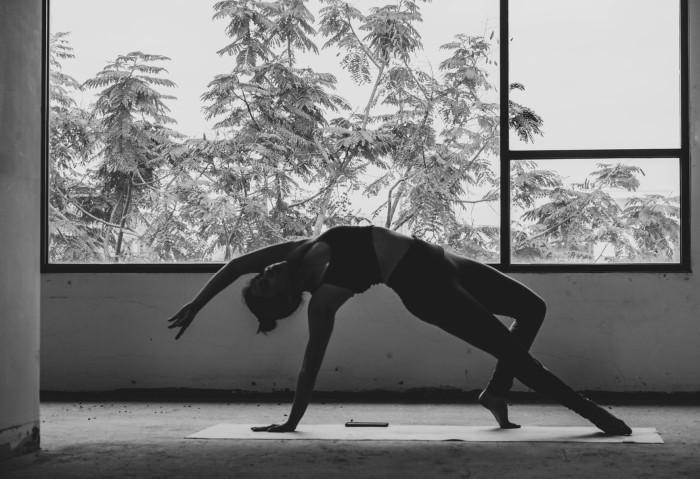As I turned my head, I contorted it to crack my neck and relieve the built-up pressure. Anger flushed through me.
My ears felt heavy, like I was descending on an airplane, and they were ready to pop.
I noticed I could feel the familiar combination of sensations and I paused to mentally review “the checklist” in my head.
My left calf was tight.
Check.
The arch of my foot was hurting.
Check.
My neck was aching.
Check.
These sensations blunted until the moment I tuned in. I had previously only been aware of being short, snappy, irritated by other people, tired, unmotivated, and overwhelmed with tasks. Disconnected from my body, I pressed myself harder to complete my task list and accomplish more.
But my rib was dislocated. Again.
The X-rays showed that the bone had moved in an inch and up an inch, but it was considered clinically insignificant, so I swatted it away and pushed myself to ignore my body and push my brain even further.
Prior to the moment I went through the checklist in my body, I was aware of…nothing.
A complex bramble of body awareness, regulation of emotions, interoception, and other brain-to-body-to-brain data and interpretation are often impacted by adverse childhood experiences. So many of us deal with back pain, sciatica, hip pain, joint pain, or other chronic pain conditions. So many of us manifest trauma as pain.
And while not everyone has physical symptoms or pain feedback due to complex trauma, the link between pain and trauma is clear: early life adversity is known to impact our ability to connect to sensation in our body.
Sensation comes in many forms, and for many reasons: we have sensations that accompany regulating our temperature, energy levels or fatigue, hunger and thirst. And there are also sensations that signal comfort, danger, and pain.
Interoception is the term to describe how accurately we are able to detect, sense, and gauge this inner experience, and it is also strongly associated with how we experience and regulate our emotions.
This means that early life traumas can make us feel chronically pained (physically or emotionally) or chronically unable to access sensation. Or sometimes, both at the same time.
And most of the time, we won’t be able to figure out why.
As a baby, I was left to cry it out. My mom was not available to breastfeed and, although not discovered until my 20s, I have a milk sensitivity that gave me lifelong ear, nose, and throat infections. I was put on formula and by six weeks old, I was given antibiotics for my first diagnosed ear infection.
My mom, the child of an alcoholic and lacking skills she was never given in attunement, witnessing, compassion/self-compassion, or self-regulation, tried her best but didn’t have the capacity to emotionally nurture and comfort me. My father, one of eight children raised by a highly reactive, explosive, and critical father and perfectionist mother, had similar emotional capacities to my mom.
And the net result was that I was criticized instead of comforted from the time I was born, a relational trauma that I had no idea impacted me until significantly into my adulthood.
My parents tried their best, yet I have no memories of being comforted as I cried, helped through anger, guilt, or shame, or taught how to regulate when panicking or freaking out.
Little did I know, as Bessel Van der Kolk says, that my body was keeping score.
There was no reason for the pain I was experiencing. I hadn’t done any strenuous activity, or exerted or contorted my body in any special or different way. Sometimes it was just from breathing.
My body was considered a mystery and challenge to my health practitioners, exercise teachers, and to myself. The pain was not only frustrating, but it was also not something the medical establishment could identify, assist with, or diagnose. While my X-ray demonstrated a bone sitting in a different place than it began, the options for treatment were few to none.
So I lived with it. I noticed that stress contributed to the dislocation, but “lowering” my stress didn’t prevent it from subluxation.
Our most common cultural solutions, namely meditation and yoga, also exacerbated it. The focus on achieving a posture and position, and cueing from teachers, who pushed us to our “edge” or required micro-adjustments of my thumbs or hips as a “safety” mechanism, was based on a skeleton, body, and experience that were not mine.
Meditation and postures turned the process of attempting to heal my body into one that created more competitiveness, intellectualizing, shame, and disconnection.
At one point, I remember an instructor telling me to feel my shoulder, and I was aware that I no longer had any sensation.
As the problem grew, I chose movement as my line of work and sought to figure out my own body (and help others do the same with theirs).
Even in teacher trainings or professional settings, I was often frustrated and ashamed at my capacity to push harder, into injurious situations, without the slightest bit of body cues to inform me of impending danger and to also feel constant pain in my neck, an area that seemed to have nothing at all to do with the sight of the “injury.”
This palpable feeling of being broken and yet capable befuddled me as I poured through books and other material to find a solution.
What I didn’t know at that time was that the answer was in my body—not in my brain.
I found a doorway to a solution through interoceptive cues. In many cases, this was a process of laying down on the floor after each exercise and noticing and naming, out loud, what changes I felt in my body.
It eventually occurred to me that I was previously moving at a level that was intolerable for my body, or that the sensation I was reaching for may not have been available to be felt.
When I started teaching movement and exercise, I felt at home. In my world, there has always been a “better” or “worse,” a “right” or a “wrong,” a graph or grid or measuring tool to establish performance.
And yet, this was the very thing that was breaking my body.
So I sought daily intentional practices that moved me toward feeling, decoding, and even responding to sensation.
As my interoceptive capacities grew, I also discovered the power of relationships in movement as a tool for healing relational trauma, and stopped going to traditional exercise and meditation classes.
Any experience where two or more people were moving together in an attuned practice of movement and shape choices, rhythms, and sensations felt different to my emotional and physical body than one where a teacher cued shapes with precision or offered commands such as “feel the cool air coming in through the nostril and the warm air leaving.”
I also recognized that the person who has experienced trauma may include the movement teacher, which in this case was now me.
I started to look for the possibility of choice in my body. I dropped the 21 day “challenges” that required me to do the same thing each day or week, and allowed for the possibility of both hyper-awareness and dissociation during the same yoga practice or over time. I held this with compassion.
I stopped coercively attempting to control my body with commands, instructions, requirements, and demands, and started listening to the information coming from within, be it a whisper or (sometimes) a shout.
And the things that used to break me now help me recover from trauma.
We have the right to move our body and connect to it as a feel-able entity.
We have the capacity to rebuild our body by way of exercise and movement that involves choice and agency.
We have the possibility of using the pain in our body as a window to heal our trauma.
We can use relationships to facilitate a new experience in our body.
And to change our capacity to feel.
~
Please consider Boosting our authors’ articles in their first week to help them win Elephant’s Ecosystem so they can get paid and write more.
~












Read 15 comments and reply